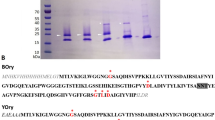Abstract
In order to better understand the role played by surface glycoconjugates during cell adhesion and endocytosis by the dematiaceous fungi Fonsecaea pedrosoi, we analyzed the interaction between this microorganism and five mutants of Chinese Hamster Ovary (CHO) cells, which differ from each other in the exposition of carbohydrate residues on the cell surface. Five clones (Gat-2 parental, and the clones: Lec1, Lec2, Lec8 and ldlLec1) were tested and the adhesion and endocytic indexes were determined after 2 hours of interaction. The Lec1 and ldlLec1 clones, which present exposed mannose residues, showed the greater adhesion index (AI). On the other hand, the Lec8 clone, which exposes N-acetylglucosamine on the cell surface, presented the greater endocytic index. The role played by surface-exposed carbohydrate residues was further analyzed by addition of mannose or N-acetylglucosamine to the interaction medium and by previous incubation of the cells in the presence of the lectins Concanavalin A (ConA) and wheat germ agglutinin (WGA). The results obtained suggest that mannose residues are involved in the first step of adhesion of F. pedrosoi to the cell surface, while N-acetylglucosamine residues are involved on its ingestion process.
Similar content being viewed by others
References
Rippon JW. Chromoblastomycosis. In: WB Sounders (ed), Medical Mycology, Philadelphia, 1988: 276–296.
Ellis DH, Griffiths DA. The location and analysis of melanins in the cell walls of some soil fungi. Am J Microbiol 1974; 20: 1379–1386.
Alviano CS, Farbiarz SR, De Souza W, Angluster J, Travassos LR. Characterization of Fonsecaea pedrosoi melanin. J Gen Microbiol 1991; 137: 837–844.
Londero AT. Chromoblastomycosis. in AI Brande (ed). Medical Microbiology and Infection diseases. WB Sounders Co, Philadelphia 1981: 1578–1581.
Hirsch BC, Jonhson WC. Pathology of granulomatous diseases: mixed inflamatory granulomas. Int J Dermatol 1984; 23: 585–597.
Londero AT, Ramos CD. Chromoblastomicose no interior do estado do Rio Grande do Sul. Bras Dermatol 1989; 64: 155–158.
Kennedy MJ. Adhesion and association mechanisms of Candida albicans. In: McGinnis MR (ed) Current topics in medical mycology. New York, Springer Verlag 1987: 73–169.
Sharon N, Lis H. Carbohydrates in cell recognition. Sci Am 1993; 268: 74–81.
Isberg RR, Tran Van Nhieu G. Binding and internalization of microorganisms by integrin receptors. Trends Microbiol 1994; 2: 10–14.
Mendes-Giannini MJS, Ricci LC, Uemura MA, Toscano E, Arns W. Infection and apparent invasion of Vero cells by Paracoccidioides brasilienses. J Med Vet Mycol 1994; 32: 189–197.
Bonilha VL, Ciavaglia MC, De Souza W, Silva Filho FC. The involvement of terminal carbohydrate of the mammalian cell 135 surface in the cytoadhesion of trichomonads. Parasitol Res 1994; 308: 718–721.
Lloyd KO, Travassos LR. Immunochemical studies on arhamno-D-mannans of Sporothrix schenckii and related fungi by use of rabbit and human antisera. Carb Res 1975; 40: 89–97.
Strobel G, Van Alfen H, Hapner KD, McNineil M, Albersheim P. Some phytotoxic glycopeptides from Ceratocystis ulmi, the Dutch Elm disease pathogen. Biochim Biophys Acta 1978; 538: 600–75.
Alviano CS, Gorin PAJ, Travassos LR. Surface polysaccharides of phytopathogenic strains of Ceratocystis paradoxa and Ceratocyti fimbriata isolated from different hosts. Exp Mycol 1979; 3: 174–187.
Travassos LR, De Souza W, Mendonça-Previato L, Lloyd KO. Location and biochemical nature of surface components reacting with Concanavalin A in different cell types Sporothrix schenkii. Exp Mycol 1977; 1: 293–305.
Souza ET, Silva-Filho FC, De Souza W, Alviano CS, Angluster J, Travassos LR. Identification of sialic acids on cell surface of hyphae and conidia of the human pathogen Fonsecaea pedrosoi. J Med Vet Mycol 1986; 24: 145–153.
Soares RMA, Angluster J, De Souza W, Alviano C. Carbohydrate and lipid components of hyphae and conidia of the human pathogen Fonsecaea pedrosoi. Mycopathologya 1995; 132: 71–77.
Chapman D. Fluidity and phase transition of cell membranes. Biomembrane 1975; 7: 1–9.
Szaniszlo PJ, Cooper BH, Vogers HS. Chemical compositions of the hyphal walls of three chromomycosis agents. Sabouraudia 1972; 10: 94–102.
Sans-Blas G. The cell wall of fungal human pathogens: Its possible role in the host-parasite relationships. Mycopathologya 1982; 79: 159–184.
Farbiarz SR, Carvalho TU, Alviano C, De Souza W. Inhibitory effect of melanin on the interaction of Fonsecaea pedrosoi with mammalian cells in vitro. J Med Vet Mycol 1992; 30: 265–273.
Farbiarz SR, De Carvalho TU, Alviano C, De Souza W. Fine structure and cytochemistry of the interaction between Fonsecaea pedrosoi and mouse resident macrophages. J Med Vet Mycol 1990; 28: 373–383.
Rozental S, Alviano CS, De Souza W. Fine structure and cytochemical study of the interaction between Fonsecaea pedrosoi and rat polymorphonuclear leukocyte. J Med Vet Mycol 1996; 34: 323–330.
Stanley P. Glycosylation mutants of animal cells. Annu Rev Genet 1984; 18: 525–552.
Stanley P. Membrane mutants of animal cells: rapid identification of those with primary defect in glycosylation. Mol Cel Biol 1985; 5: 923–929.
Li E, Becker A, Samuel L, Stanley Jr. Chinese hamster ovary cells deficient in N-acetylglucosaminyltransferase I activity are resistant to Entamoeba histolytica – mediated cytotoxicity. Infect Immun 1989; 57: 8–12.
Ciavaglia MC, De Carvalho TU, De Souza W. Interaction of Trypanosoma cruzi with cells with altered glycosylation patterns. Biochem Biophys Res Comm 1993; 193: 718–721.
Oliveira LG, Resende MA, Lopes CF, Cisalpino EO. Isolamento e identificaç ão dos agentes da cromomicose em Belo Horizonte. Rev Soc Bras Med Trop 1973; 7: 1–10.
Booth C. Fungal Culture media. In: Academic Press (ed), Methods in Microbiology. New York, 1971, 49–94.
Krieger M, Redy P, Kosarsky K, Kinsgley D, Hobbie L, Penman M. Analysis of the synthesis, intracellular sorting and function of glycoproteins using a mammalian cell mutant with reversible glycosylation defects. Meth Cell Biol 1989; 32: 57–84.
Author information
Authors and Affiliations
Rights and permissions
About this article
Cite this article
Limongi, C.L., Rozental, S., Alviano, C.S. et al. The influence of surface carbohydrates on the interaction of Fonsecaea pedrosoi with Chinese Hamster Ovary glycosylation mutant cells. Mycopathologia 138, 127–135 (1997). https://doi.org/10.1023/A:1006841529438
Issue Date:
DOI: https://doi.org/10.1023/A:1006841529438




